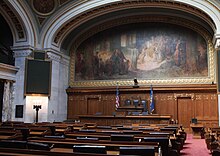Loading AI tools
Lower house of the Wisconsin Legislature From Wikipedia, the free encyclopedia
The Wisconsin State Assembly is the lower house of the Wisconsin Legislature. Together with the smaller Wisconsin Senate, the two constitute the legislative branch of the U.S. state of Wisconsin.
Wisconsin State Assembly | |
|---|---|
| Wisconsin State Legislature | |
 | |
| Type | |
| Type | |
Term limits | None |
| History | |
New session started | January 3, 2023 |
| Leadership | |
Speaker pro tempore | |
Majority Leader | |
Minority Leader | |
| Structure | |
| Seats | 99 |
 | |
Political groups | Majority
Minority |
Length of term | 2 years |
| Authority | Article IV, Wisconsin Constitution |
| Salary | $57,408/year + $155.70 per diem |
| Elections | |
Last election | November 5, 2024 |
Next election | November 3, 2026 |
| Redistricting | Legislative control |
| Meeting place | |
 | |
| State Assembly Chamber Wisconsin State Capitol Madison, Wisconsin | |
| Website | |
| Wisconsin State Assembly | |
Representatives are elected for two-year terms, elected during the fall elections. If a vacancy occurs in an Assembly seat between elections, it may be filled only by a special election.
The Wisconsin Constitution limits the size of the State Assembly to between 54 and 100 members inclusive. Since 1973, the state has been divided into 99 Assembly districts apportioned amongst the state based on population as determined by the decennial census, for a total of 99 representatives. From 1848 to 1853 there were 66 assembly districts; from 1854 to 1856, 82 districts; from 1857 to 1861, 97 districts; and from 1862 to 1972, 100 districts.[1] The size of the Wisconsin State Senate is tied to the size of the Assembly; it must be between one-fourth and one-third the size of the Assembly. Presently, the Senate has 33 members, with each Senate district formed by combining three neighboring Assembly districts.
The Assembly chamber is located in the west wing of the Wisconsin State Capitol building, in Madison, Wisconsin.
The United States first organized Wisconsin in 1787 under the Northwest Ordinance after Great Britain yielded the land to them in the Treaty of Paris. It became the Wisconsin Territory in 1836. The then-territorial assembly, after elections, was seated in Burlington for three sessions before they relocated to the permanent capital, Madison.
During the period of territorial assembly, the assembled members helped to set up the court system, established the borders and number of counties, and regularized the spelling of Wisconsin. In 1842, an assemblyman (Charles Arndt, a Whig of Brown County) was shot dead by another assemblyman, James Vineyard, a Democrat of Grant County, over an appointment for Grant County sheriff.
Wisconsin became a U.S. state on May 29, 1848, and special elections were held to fill the first session of the State Assembly; at the time, the body consisted of 66 members.[2] The Assembly was expanded to 82 seats in 1852, and then to 97 seats in 1856, then to 100 seats in 1861, which is the maximum allowed in the Constitution of Wisconsin. The membership remained at 100 seats until the 1971 redistricting act, which decreased membership to 99 in order to comply with federal equal representation requirements within the limits of the Wisconsin Constitution. The current number of 99 seats is set in order to maintain a 3:1 ratio of Assembly to Senate seats.
On July 8, 2015, a case was filed with the U.S. District Court for the Western District of Wisconsin arguing that Wisconsin's 2011 state assembly map was unconstitutional partisan gerrymandering favoring the Republican-controlled legislature which discriminated against Democratic voters. This case became filed with the court as Whitford v Gill.[3] The case made it to the United States Supreme Court, which vacated and remanded the case. The Supreme Court held that the plaintiff challenging the state assembly map did not have standing to sue. In the Opinion of the Court, Chief Justice John Roberts stated that "[a] federal court is not 'a forum for generalized grievances," and the requirement of such a personal stake 'ensures that courts exercise power that is judicial in nature." Gill v. Whitford, 128 S.Ct. 1916 (2018). We enforce that requirement by insisting that a plaintiff [have] Article III standing..." Justice Elena Kagan filed a concurring opinion, in which Justices Ruth Bader Ginsburg, Stephen Breyer, and Sonia Sotomayor joined. Justice Clarence Thomas filed an opinion concurring in part and concurring in the judgment, in which Justice Neil Gorsuch joined.[4]

Representatives elected or re-elected in the fall of 2016 receive an annual salary of $57,408.[5]
In addition to their salaries, representatives are allowed to claim a per diem for travel expenses. The maximum rate is set by the 2001 Wisconsin Act 16 to 90% of the U.S. General Services Administration rate, but the houses are permitted to establish additional criteria for determining per diem. The State Assembly per diem is set to $155.70 per overnight stay and $77.85 for day visits. A maximum of 153 days may be claimed for per diem in 2023, and 80 days may be claimed in 2024. Over two years, each representative is allotted $12,000 to cover general office expenses, printing, postage and district mailings.
According to a 1960 study, at that time Assembly salaries and benefits were so low that in Milwaukee County, positions on the County Board of Supervisors and the Milwaukee Common Council were considered more desirable than seats in the Assembly, and an average of 23% of Milwaukee legislators did not seek re-election. This pattern was not seen to hold to the same extent in the rest of the state, where local offices tended to pay less well.[6]
| ↓ | |
| 45 | 54 |
| Democratic | Republican |
| Affiliation | Party (Shading indicates majority caucus) |
Vacant | ||
|---|---|---|---|---|
| Democratic | Republican | Total | ||
| Begin of 101st legislature (2013) | 39 | 59 | 98 | 1 |
| End 101st (2014) | 60 | 99 | 0 | |
| Begin 102nd (2015) | 36 | 63 | 99 | 0 |
| End 102nd (2016) | ||||
| Begin 103rd (2017) | 35 | 64 | 99 | 0 |
| End 103rd (2018) | ||||
| Begin 104th (2019) | 36 | 63 | 99 | 0 |
| End 104th (2020) | 34 | 62 | 96 | 3 |
| Begin 105th (2021) | 38 | 60 | 98 | 1 |
| End 105th (2022) | 38 | 57 | 95 | 4 |
| Begin 106th (2023) | 35 | 64 | 99 | 0 |
| Current composition | 34 | 98 | 1 | |
| Latest voting share | 34.7% | 65.3% | ||
| Position | Name | Party | ||
|---|---|---|---|---|
| Speaker | Robin Vos | Republican | ||
| Speaker Pro Tempore | Kevin D. Petersen | Republican | ||
| Majority Leader | Tyler August | Republican | ||
| Assistant Majority Leader | Jon Plumer | Republican | ||
| Majority Caucus Chair | Rob Summerfield | Republican | ||
| Minority Leader | Greta Neubauer | Democratic | ||
| Assistant Minority Leader | Kalan Haywood | Democratic | ||
| Minority Caucus Chair | Lisa Subeck | Democratic | ||
| Chief Clerk | Ted Blazel | |||
| Sergeant-at-Arms | Anne Tonnon Byers | |||
The corresponding state senate districts are shown as a senate district is formed by nesting three assembly districts.
The following is a list of the Assembly Committees:[7]
Seamless Wikipedia browsing. On steroids.
Every time you click a link to Wikipedia, Wiktionary or Wikiquote in your browser's search results, it will show the modern Wikiwand interface.
Wikiwand extension is a five stars, simple, with minimum permission required to keep your browsing private, safe and transparent.